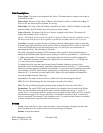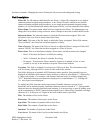could be used, for example, to reduce the size of each data request on a slow network.
The internal cached Alarm and Event list is displayed by the hpssadm program by means of its "alarm
list" command. This command has a "-c" option to specify how many of the most recent log messages in
the internal copy to display. If more messages are requested than exist in the internal list, the full internal
list is displayed. See the hpssadm man page for details.
The internal cached Alarm and Event list is displayed by the hpssgui in the Alarm and Events window as
described in Section 5.2.2.3: on page 151. The maximum number of log messages displayed in the
window is set by the HPSS_SSM_ALARM_DISPLAY environment variable, which may be overridden
by the "-N" option to the hpssgui startup script. The default is to display at most 2000 messages in the
list.
If the maximum number of messages to retrieve (HPSS_SSM_ALARM_GET or -G option) is greater
than the maximum number of messages to display (HPSS_SSM_ALARM_DISPLAY or -N option), it
will be reset to the same value as the maximum number of messages to display. This is true for both the
hpssgui and the hpssadm, although the hpssadm does not use the maximum number of messages to
display value for anything else.
If new messages are arriving regularly, the messages displayed by the hpssgui Alarms and Events
window will constantly be moving downward at set intervals. This can make it difficult to select a
specific message if the window is updating frequently. This problem can be minimized by being careful
to click on a message immediately after an update cycle, or it can be eliminated entirely by freezing the
display by checking the Freeze checkbox at the bottom of the Alarms and Events window.
If many messages are arriving very rapidly, or if you leave the Freeze button on, it is possible for the
display to become stale. A stale message is one which is still visible, but which has been discarded from
the cache. If you click on such a message, an error box will appear, telling you that the selected message
is no longer available.
Messages are displayed in the order in which they are received by the System Manager. They are not
sorted by the event time displayed with each message, so if many messages are generated in a short
period of time, it is possible to see messages which are displayed slightly out of chronological order.
Each hpssgui user can filter and sort what is shown on his own Alarms and Events window independently
of any other hpssgui user. See Section 3.10: SSM List Preferences on page 69 for information on
filtering and sorting alarms. Filtering and sorting of the Alarms and Events list are not yet available for
hpssadm users.
HPSS Management Guide November 2009
Release 7.3 (Revision 1.0) 307


















